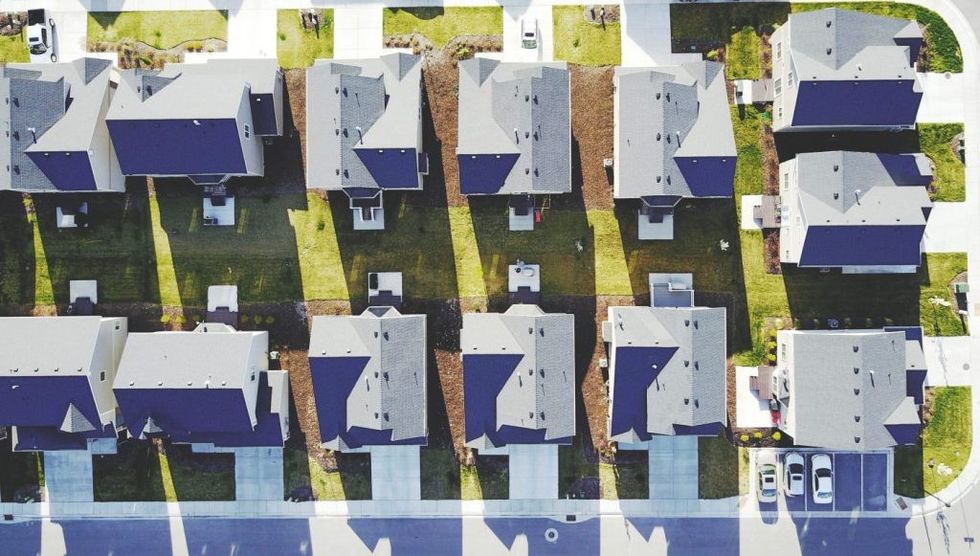
[ad_1]
In Canada, the houses earn a lot more than the people who live in them — not to mention, those who have been priced out of the red-hot housing market altogether.
Ben Rabidoux, the founder at Edge Realty Analytics Ltd., produced a handful of charts based on data from the Canadian Real Estate Association (CREA) that captures the country’s dramatic (to put it lightly) real estate scene in 2021. He posted them in a series of tweets.
And for would-be first-time homeowners, the picture they paint isn’t exactly an uplifting one. In fact — brace yourselves — the charts show, clear as day, that the typical house price rose $160,000 year-over-year in Canada, a figure that’s tax-free on primary residences.
This means that you’d have to make $270,000 of pre-tax income to “earn” as much as the typical house did in the past year, highlights Rabidoux. Gulp.
READ: Price Gap Between Toronto’s Detached Homes and Condos Now Largest Ever
The charts also reveal that Canada’s home sales have already set an annual record with one month still to go and are on pace to pass the previous record by 21%. Of course, they also reveal the jaw-dropping surge in home prices across the country, including a record real house price growth in Q2.
Home sales surged across the country and have already set an annual record with one month still to go. On pace to pass previous record by 21%! 2/ pic.twitter.com/64sZnpBhNY
— Ben Rabidoux (@BenRabidoux) December 29, 2021
“With unit sales and prices up massively, the total dollar volume of homes sold over the past year surged to nearly $450B or the equivalent of 18% of GDP, both records by far,” writes Rabidoux.
Naturally, the charts come as no surprise to anyone who’s followed the wild ride that is the pandemic-times Canadian real estate market. In fact, many defeated young people don’t need the reminder, thank you.
Prices have surged and we saw record real house price growth in Q2. 3/ pic.twitter.com/uFQiYTnTeL
— Ben Rabidoux (@BenRabidoux) December 29, 2021
In the tweets, Rabidoux also highlights notable activity on the mortgage front, showing how mortgage origins “exploded” and hit records both in dollar terms and as a share of the GDP. Furthermore, credit trends were exceptional, writes Rabidoux.
“Consumer insolvencies fell to 20-year lows. Business insolvencies hit 30-yr lows. Monthly credit card trust data continues to look fantastic with payment rates and delinquencies the best on record,” he tweeted.
In the final in the series of eight tweets, Rabidoux points to immigration — something that undoubtedly has a major impact on Canada’s housing market. “Population growth is still not back to 2019 highs but has rebounded strongly on the back of record immigration,” he writes.
Arguably, the most hard-hitting takeaway of the tweets, however — especially for young people literally kept awake at night with financial worry — is the undeniable reality that home prices are completely out of whack with income levels and increasing at rates that seem less and less attainable for those not already in the housing market.
In nominal terms, the typical house price in Canada rose $160,000 y/y in November. And that’s TAX FREE for primary residences. You’d have to make over $270,000 of pre-tax income to “earn” as much as the typical home did in the past year. 4/ pic.twitter.com/mFXR8LqUz9
— Ben Rabidoux (@BenRabidoux) December 29, 2021
So, what’s in store for 2022? (AKA can it get any worse?)
“I think the market is going to stay fairly imbalanced at least for the first part of the year in the sense that demand is going to continue to outstrip supply. It’s just hard to see where the supply is going to come from,” Rabidoux tells STOREYS. “You have record homes under construction, but it’s not necessarily the type of homes that people want. One-third of the homes under construction are rental units. When you look at single-family — the segment that’s most in-demand — we’re not building any more than we were 20 years ago. In fact, we’re building less.”
It’s unclear how we will see this reality change, says Rabidoux.
“I do think we will start seeing the combined impact of rising rates and potentially new regulations to cool investor demand. This will have the effect of muting some of that demand,” says Rabidoux. “From the perspective of how crazy strong this year was; it’s really hard to build on a year like that. Normally, the market takes a pause after the sort of run-up that we’ve seen. I think the back half of next year will be a little more subdued but I think it’s still setting up for a strong spring selling season.”
In terms of some relief, Rabidoux stresses that there isn’t one solution to cool the increasingly defeating housing market. “Everyone is looking for a simple solution,” he says. “The reality is, to move the needle, you need a combination of thoughtful solutions.”
Targeting investors alone isn’t going to have a substantial impact, says Rabidoux.
“I think what would be smarter, to the extent that there is foreign capital coming in and speculation in Canadian housing — that needs to be addressed,” says Rabidoux. “The government has talked about putting a moratorium on foreign buyers; that’s all well and good but that doesn’t work if people can buy through a third-party company. That brings us back to the need for a beneficial ownership registry. We need to know who owns the homes; if it’s not a Canadian, then that becomes a policy discussion.”
At the end of the day, the biggest problem plaguing cities of all sizes throughout the country is a glaringly apparent lack of supply.

“The supply challenges are very real and there is a misalignment between the federal government and their immigration targeting — which we need and is healthy — and the ability or willingness of municipalities to deliver the housing needed to accommodate that,” says Rabidoux. “It’s a real problem; it’s a policy crisis. So, we need incentives for municipalities to get off their butts and tell the NIMBY crowd to take a hike, and that we need more supply.”
Rabidoux points to the government’s discussion of options of tying certain finding to the ability of municipalities to hit these targets, which he calls important. He also highlights the need for — an admittedly “taboo” — conversation surrounding immigration targets and policy.
“Any rational person realizes we need a healthy level of immigration,” says Rabidoux. “The issue is that what we are targeting right now is total GDP growth, which is simply the economic output multiplied by population, effectively. So, if you increase your population, your GDP goes up. But the GDP per capita doesn’t necessarily go up. We’re finding that the current pool of immigrants are effectively the same age as the Canadian population. So, you aren’t getting the benefit of a younger cohort through immigration policies.”
This, says Rabidoux, raises the question of whether we should be more thoughtful in trying to attract younger and specifically talented people in our immigration pool, as opposed to focusing on absolute numbers.
“You can distill that down to a discussion about thoughtful immigration reforms, which is super taboo; but we’re in a housing affordability crisis, so we should have every policy option on the table,” says Rabidoux. “If that means things like rethinking tax policy, maybe that’s not a horrible idea. Should someone who is a millionaire living in a $10M house that’s appreciated 50% over the past couple of years be allowed to live tax-free? Or should we be incentivizing someone like that to re-invest some of that they clearly don’t need for their basic survival into creating jobs for the rest of the country?”
He admits this idea is a “super controversial” one but stresses, again, that all options should be explored in times of crisis.
At the end of the day, a lack of supply is front and centre to Canada’s housing crisis, but there is no silver bullet solution. Rather, “a combination of factors that hopefully bring some change,” says Rabidoux. Well, here’s to hoping.
[ad_2]
Source link